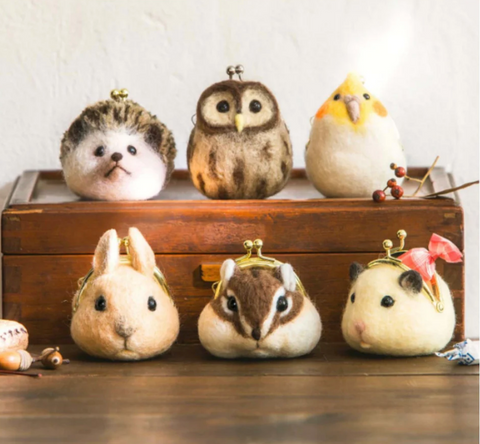
Needle felting is a popular craft that involves using a special barbed needle to sculpt wool fibers into various shapes and forms. The wool used for needle felting comes in many different types and textures, each with its unique properties and benefits.
One of the most commonly used types of wool for needle felting is sheep's wool, which comes in a variety of natural colors and is easy to work with. Merino wool, in particular, is popular among needle felters due to its fine texture and ability to hold its shape well. It's also hypoallergenic, making it a great option for those with sensitive skin.
Alpaca wool is another popular choice for needle felting. It's soft and lightweight, making it ideal for creating fluffy animals or delicate details. It also comes in a wide range of natural colors, including shades of brown, grey, and white.
Other types of wool that can be used for needle felting include llama wool, cashmere, angora, and even synthetic wool blends. Each type of wool has its unique characteristics, which can affect the final outcome of the needle-felted project.
When it comes to needle felting, the quality of the wool used is crucial. Poor quality wool can make the felting process more challenging and result in an inferior finished product. It's essential to choose high-quality wool that is clean, free of debris, and has not been chemically treated.

In addition to wool, other materials can be used in the needle felting process, such as wire, armature, and felting needles of different sizes and shapes. These materials can help create more complex shapes and add extra support to the finished product.
Needle felting wool is a versatile and satisfying craft that allows you to create a wide range of objects and sculptures. Whether you're a seasoned needle felter or a beginner, the type of wool you choose can make a significant difference in the outcome of your project. So, take some time to experiment with different types of wool and see which one works best for you and your needle felting projects.
- Needle felting supplies
- Wool roving
- Felting needles
- Felting techniques
- Needle felting kits
- DIY felting
- Fiber arts
- Handmade crafts
- Wool sculpture
- Textile art
- Wool crafts
- Needle felted animals
- Needle felted dolls
- Wool painting
- Wool felt
- Wool fibers
- Wool spinning
- Wool blending
The Art of Needle Felting Wool: Tips, Tricks, and Techniques

Electric Needle felting tools , usually takes 1 hour of work 15 minutes to complete
Needle felting wool is a fun and creative craft that allows you to create beautiful, three-dimensional sculptures using just a needle and some wool. It's a versatile craft that can be used to make everything from cute animals to intricate landscapes, and it's easy to learn even if you've never tried needle felting before. In this article, we'll take a closer look at needle felting wool, including the tools and techniques you'll need to get started.
Tools of the Trade
The first step to needle felting wool is to gather the necessary tools. At a minimum, you'll need a felting needle, wool roving, and a foam pad. Felting needles come in different sizes, from fine to coarse, and each size is used for different purposes. Fine needles are best for creating details and finishing touches, while coarse needles are best for creating the initial shape of your sculpture.
Wool roving is the material that you'll be felting with the needles. It comes in a variety of colors and can be blended together to create custom colors. You'll want to choose a high-quality wool roving that is soft and easy to work with.
The foam pad is used to protect your work surface and to give you a surface to work on that will allow the needles to penetrate the wool.

Needle felted sheep kit with lights
Techniques
Once you have your tools, it's time to start felting! The basic technique involves repeatedly poking the wool roving with the felting needle. The barbs on the needle cause the fibers of the wool to interlock and become denser, creating a solid shape.
To start, create a small ball of wool roving and start poking it with the needle. As you work, the wool will start to take shape. Use coarse needles to shape the wool and fine needles for details.
To create different shapes, you can use armatures, which are wire structures that give your sculpture structure and support. Armatures can be made from a variety of materials, such as pipe cleaners or floral wire.
Tips and Tricks
Here are a few tips and tricks to keep in mind as you needle felt:
-
Be patient. Needle felting is a slow process that requires a lot of patience and attention to detail.
-
Use a light touch. It's easy to accidentally break your needle by poking too hard or at the wrong angle.
-
Start small. It's best to start with small projects, such as a simple ball or a small animal, before moving on to more complex sculptures.
-
Blend colors. You can blend different colors of wool roving together to create custom colors and textures.
-
Take breaks. Needle felting can be hard on your hands and fingers, so be sure to take breaks and stretch your hands and wrists.
Conclusion
Needle felting wool is a fun and rewarding craft that can be enjoyed by crafters of all skill levels. With the right tools and techniques, you can create beautiful and intricate sculptures that will amaze and delight. Whether you're making a cute animal or a beautiful landscape, needle felting is a craft that is sure to bring you joy and creativity. So, grab your needles and wool and start felting!
